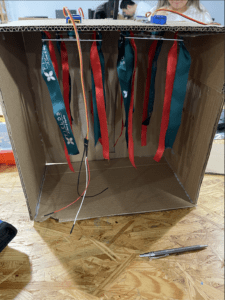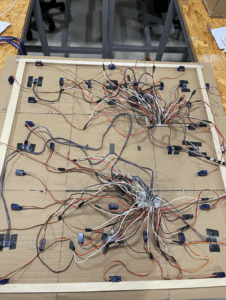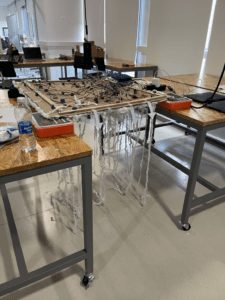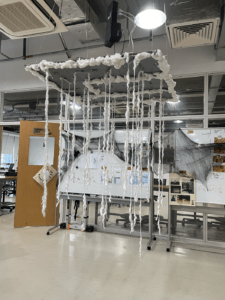Cloudy With a Chance of Servos- Luciana Emerson – Rudi Cossovich
- CONTEXT AND SIGNIFICANCE
Address how your previous research (Group Project) impacts or inspires your midterm project. Analyze the previous projects and interactions that you have researched. Point to what specifically in those projects triggered your understanding of interaction, and then your definition of it. What is unique and/or significant about your project? If you re-created something that already exists, explain what your take is on that existing project and what your contribution is to its development? For who is your project intended and why is it of special value to its targeted audience?
During the group project, I gained an understanding of what interaction is and the components that need to be added in order to make something interactive. Though the glasses we imagined were not very similar to what I made for my midterm project, they did inspire me to incorporate motion sensors into my design. In my “research” part of the project, I talked about the Rain Room created by Hannes Koach and Florian Ortkrass. The immersive experience that the Rain Room offers matches my definition of interaction because as the user moves around the room, the room reacts and stops rain from falling. The way that the room responds and the person reacts creates an unspoken conversation that is an interaction. My midterm project was inspired by the immersive aspect of their design. I really wanted my project to be a sensory experience where the people would feel how I imagined a cloud felt when I was little. My partner and I wanted to encourage curiosity so my project has no intended person but is open to anyone who is curious enough to walk under it.
- CONCEPTION AND DESIGN:
In what ways did your understanding of how your users were going to interact with your project inform certain design decisions you made? Account for several such decisions. In addition, what form, material or elements did you use? What criteria did you use to select those materials? Why was it/were they best suited to your project purpose, more than any other one/s? What might have been another option? But you rejected it—why?
My partner and I wanted the interaction to not need instructions. We wanted curious people to walk under the project and then figure out how it works so we tried to make the motion sensors hidden at the top of our project. We initially were just thinking about aesthetics so we wanted to use ribbon so when the servos moved there would be a ripple effect. When we made our prototype, however, we realized that the ribbon actually created more of a carwash feeling so we rejected that idea. When creating our final piece we found really soft white yarn that felt like clouds and strung them from the servos to create the sensory aspect of the design. Because we like the cloud-like feeling of the yarn, we wanted to keep that a theme throughout our project. We also wanted to create a fantasy-like experience and added led lights around the board to make it seem as if you were under a rainbow. When the servo detected movement, the section of LEDs the user was closest to would light up. We also added cotton balls over the LEDs to keep the cloud theme.
- FABRICATION AND PRODUCTION:
In this section, describe and assess the most significant steps in your production process, both in terms of failures and successes. Please clarify exactly what contributions and roles you personally made to the process and project along the way, and describe the process your group used to work together. What happened during the User Testing Session? How did your user testing process influence some of your following production decisions? What kind of adaptations did you make? Were they effective? In short, keeping in mind your project goals, how do you account for and justify the various production choices you made for your project? Include sketches and drawings.
When creating the prototype the process was very straightforward. As we only used four servos, daniel did the coding and I created the physical part of the project. While he was experimenting with how the servos and LEDs worked, I played with different layouts of how the project could look and then created the prototype. The prototype consisted of 4 servos. Two were connected to one distance sensor and two were connected to another. During user testing, we got some critiques about how the interaction should be more obvious to the user but other than that it went smoothly. Since we downsized our prototype, many were very interested in how the final would turn out. Since our prototype used ribbon it felt like a hand carwash so for our final we replaced the ribbon with yarn. We also upgraded and added 28 more servos and 6 more motion sensors to the final piece because we wanted people to be able to move under our project and notice the stop and start of the moving strings.
When creating the final project, I resumed the role of designing the physical board and mechanism while daniel did the coding. Additionally, we both worked on the circuits. When doing the circuits we had to re-wire four times because we kept not being able to figure out why it didn’t work. The addition of the 28 servos soon became a nightmare and we could only get one side of the project to work by the time we had to present it. When we presented it, the project was a complete failure. The servos had interference so even the half that was working wasn’t very obvious how it interacted with the user. We were so annoyed and tempted to give up.
After a day of contemplating we realized that we didn’t want our time and effort to go to waste. Thankfully our instructor gave us an extra few days to work on the project. We took away half the servos and the board was running smoothly. We were able to string our project up in the classroom so now other people can interact with it too.
- CONCLUSIONS:
Begin your conclusion by restating the goals of your project. How do your project results align with your definition of interaction? How do your project results not align with your definition of interaction? Based on both your definition of interaction and your expectations of your audience’s response, how, ultimately, did your audience interact with your project? How would you improve your project if you had more time? What of value have you learned from any setbacks and/or failures? What do you take away from your accomplishments?
The wrap-up of your conclusion delivers your final say on the issues you have raised previously, demonstrates the importance of your ideas, and insightfully synthesizes your thoughts about key elements of the project experience. As such, your conclusion should close by reflecting on the crucial questions “So what?” and “Why should anybody care?”
My partner and I came into this project with really big hopes. We wanted to create an immersive art installation that was inspired by clouds. We imagined users being able to walk underneath the installation and have the servos move with them so that the strings would tickle them. We installed LED lights to further immerse the user into the experience. Though we had our ups and downs, the final project is something that both my partner and I are really proud of.
I think that though my project matches my definition of interaction perfectly, other people might not agree with me. Personally, I believe that my project matches the definition of interaction because it responds to the user’s movements. But other people might think that in order for something to be interactive there must be added components like sound.
Watching people finally be able to interact with our project was very rewarding. It was so fun to see people playing around with the installation seeing how fast the motion sensors responded. People would walk under it slowly and then turn around and sprint to the other side. It was very fun to see people let out their inner child while interacting with our project. If we had more time I think that we could have focused more on aesthetics. I think that though our project worked well, the loose wires were messy and an eyesore. I also think that if we had more time we could have made the whole ceiling lined with cotton so the project looked like an actual cloud. If I were to add more to the actual project I would have added music to go with the lights to mute out the sound of the servo motors.
My partner and I ran into many failures along the way from the servos not working to the lights not turning on. I think the biggest takeaway I got from this project is perseverance. My partner and I were just about ready to abandon the project when it didn’t work during the presentation but we decided that we needed to finish the project for ourselves. I learned that with enough determination I can complete anything I put my mind to and that it’s much more rewarding than excepting a loss.
Instead of focusing on a major problem in the world, our project focuses on bringing out the playful side of people. Though college is a stressful time for everyone there are still moments to let go and have fun. Our project encourages the curiosity and childlike emotions that are rooted within us and bring them out to shine.
- ANNEX: All documentation you wish to include but was not closely related to your reflection should go in this section. All the images, the full code, circuit diagrams, materials list, poster, and video(s) of your project should be in their corresponding section when they are relevan. For example: a series of sketches you made while refining your idea should be in the CONCEPT section, where you explain how you refined your idea; an excerpt of the code should be in the PRODUCTION section, clarifying an experiment you tried, a full video of a user interacting with your project should be in your CONCLUSIONS section, etc.
Prototype of the design
Wiring of final project
final project before being hung
Project finished and hung up
CODE:




Leave a Reply